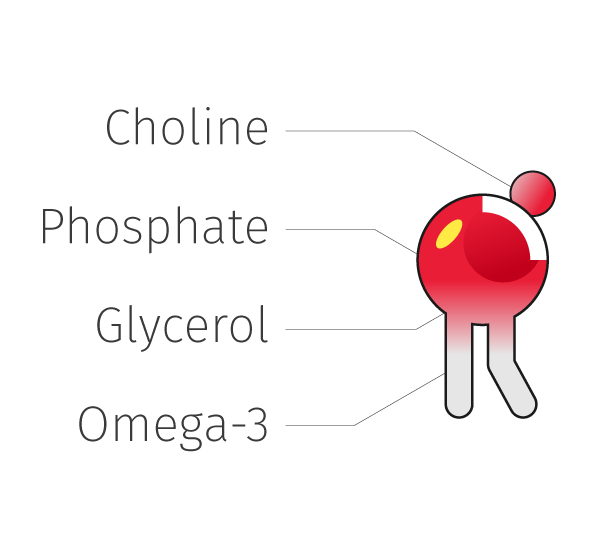What Are Omega-3s?
Omega-3 fatty acids are a group of essential polyunsaturated fatty acids (PUFAs) that play a critical role in maintaining various physiological functions in the body. There are three main types of omega-3 fatty acids, alpha-linolenic acid (ALA) to eicosapentaenoic acid (EPA) and docosahexaenoic acid (DHA). Out of the three, ALA is considered "essential" because the body cannot produce them on its own, so they must be obtained from dietary sources. ALA can be converted by the body to create EPA and DHA, but that conversion rate is quite low. Studies suggest that only a small fraction of ALA is converted to EPA (approximately 5-10%) and even less to DHA (usually less than 1%).2
Getting enough EPA and DHA is important for maintaining overall health because they support critical functions in the body. EPA helps reduce inflammation, lower triglyceride levels, and promote heart health, reducing the risk of cardiovascular diseases. DHA is vital for brain development, cognitive function, and eye health, especially in maintaining the structure and function of cell membranes.
Omega-3s have played a key role in human evolution and development. A turning point for the evolution of human intelligence was the diet change from red meat of animals mainly consumed by the Neanderthals to the inclusion of coastal seafood and inland freshwater sources.2 This might have initiated the growth of the brain about two million years ago.
OMEGA-3 TABLE OF CONTENTS
![]()
![]()
![]()
![]()
![]()
Krill oil: Phospholipid Omega-3 EPA/DHA
Krill oil is naturally made up of phospholipid-bound omega-3 EPA/DHA as well as the essential nutrient choline and the antioxidant astaxanthin. It has been clinically shown to increase omega-3s levels while providing multiple health benefits.
Krill oil omega-3 EPA/DHA come in the exact form our body needs, phospholipids. Other omega-3 EPA/DHA forms need to be converted into phospholipids in order to integrated into your body's cell members to be delivered where they are need most.
FORM MATTERS
Omega-3 EPA/DHA Forms
Omega-3 EPA/DHA come in different molecular forms, primarily distinguished by their chemical structure and how they are bound in foods or supplements. These different forms influence how omega-3s are absorbed, utilized, and delivered in the body.
Krill oil Omega-3 Advantage: Krill oil is phospholipid bound omega-3s more easily digested and then absorbed by our cells.
WATER & OIL-BASED
PHOSPHOLIPIDS 
Structure: Phospholipids have two fatty acids attached to a glycerol backbone with a phosphate group, making them water- and fat-soluble. Omega-3s EPA/DHA are bound to phospholipids in krill oil.
Sources: Found naturally in krill oil and fatty fish like salmon.
Digestion: Phospholipid omega-3s are both water and oil soluble so they mix easily with the contents of your stomach making it easily digested without fishy burps or after taste.
Absorption: Our cell membranes are made up of a phospholipid bilayer making phospholipids omega-3 EPA/DHA the exact form our body needs.
OIL-BASED
TRIGLYCERIDES
 Structure: Omega-3 EPA/DHA in triglyceride form consist of three fatty acids attached to a glycerol backbone. This is the natural form in most fish oils.
Structure: Omega-3 EPA/DHA in triglyceride form consist of three fatty acids attached to a glycerol backbone. This is the natural form in most fish oils.
Sources: Naturally occurring in fish and other marine oils.
Digestion: Being oil-based, triglycerides do not mix as easily with the contents of your stomach which causes fishy burps. It's recommended to eat a fatty meal with triglyceride omega-3 EPA/DHA so they can be more easily digested and absorbed your body. Eating a fatty meal triggers your body to create bile which helps break down fats like triglycerides
Absorption: Triglycerides can be used in your body for energy, fat storaged or transformed into phospholipids so that the omega-3 EPA/DHA can be integrated into your cell membranes.
OIL-BASED
ETHYL ESTERS
 Structure: This is a synthetic form of omega-3 EPA/DHA that are bound to ethanol (an alcohol molecule) instead of glycerol.
Structure: This is a synthetic form of omega-3 EPA/DHA that are bound to ethanol (an alcohol molecule) instead of glycerol.
Sources: Mostly in very highly concentrated omega-3 supplements and pharmaceuticals.
Digestion: Ethyl esters are similar to triglycerides in which they can cause fishy burps. Eating a fatty meal is even more necessary for digestion and absorption.
Absorption: Ethyl esters are less efficiently absorbed than triglycerides and phospholipids, requiring the body to first convert them back into triglycerides and then phospholipids for the omega-3 EPA/DHA to be integrated into your cell membranes. With this low bioavailability, you need to take larger doses of ethyl esters to get similar benefits as the other forms.
MOST RESEARCHED SUPPLEMENT INGREDIENT3
Research on Omega-3 EPA/DHA
| Studies on NIH PubMed: |
40,000+ |
According to the National Institute for Health (NIH) PubMed database, omega-3s are the most researched supplement ingredient with over 40,000 search results.3 Omega-3 EPA/DHA have been extensively studied for their cardiovascular, cognitive, and anti-inflammatory benefits. The number of clinical trials and epidemiological studies focused on their health effects is large and continues to grow.
Krill Oil Studies: 135+
Importance of Omega-3 to Omega-6 Ratio
The balance between omega-3 and omega-6 fatty acids in the diet is crucial. Both are needed, but high levels of omega-6 (found in vegetable oils and processed foods) can lead to inflammation, especially when omega-3 intake is too low. A better balance between omega-6 and omega-3 is associated with reduced inflammation.
Omega-3s are vital for overall health, and regular consumption through diet or supplements like krill oil is recommended to meet the body's needs for EPA and DHA.
Top Researched Health Benefits of Omega-3 EPA/DHA
Omega-3 EPA/DHA are crucial for maintaining cellular integrity, reducing inflammation, and supporting the health of vital organs such as the heart, brain, eyes, skin, and liver. Their broad range of benefits makes them essential for overall health and well-being.
HEART HEALTH
The number of studies specifically investigating omega-3 EPA/DHA and heart health is substantial, with estimates suggesting over 4,000 to 5,000 studies.3 These studies range from observational research to clinical trials and meta-analyses, focusing on how omega-3 EPA/DHA affect various aspects of cardiovascular health
Key areas of research include:
- Triglyceride Reduction: Omega-3 EPA/DHA have been shown to significantly reduce triglyceride levels, a key risk factor for heart disease.
- Blood Pressure Control: Clinical trials have consistently found that omega-3 EPA/DHA supplementation can help reduce blood pressure, contributing to better heart health.
- Heart Disease and Stroke: There are numerous studies showing a correlation between higher omega-3 EPA/DHA intake and a reduced risk of cardiovascular events like heart attacks and strokes.
- Anti-inflammatory Effects: Omega-3 EPA/DHA help reduce inflammation, which is a major contributor to atherosclerosis and other cardiovascular issues
COGNITIVE HEALTH
The estimated number of studies on omega-3 EPA/DHA and cognitive health is over 2,000 to 3,000.3 These studies include a variety of research types, such as randomized controlled trials, observational studies, meta-analyses, and reviews focusing on the impact of omega-3 EPA/DHA on brain health, cognitive function, and neurodegenerative diseases like Alzheimer’s.
Key areas of research include:
- Memory: Studies explore how DHA affects memory retention and cognitive performance.
- Learning and Brain Function: Research often focuses on omega-3 EPA/DHA's role in enhancing brain plasticity and learning capacity, especially in aging populations.
- Neurodegenerative Diseases: A significant body of research investigates the role of omega-3 EPA/DHA in preventing or slowing the progression of conditions like Alzheimer’s and other forms of dementia.
_________________________________________________
EYE HEALTH
The estimated number of studies on omega-3 EPA/DHA and eye health is over 1,000 to 1,500.3 These studies encompass research on the effects of omega-3s on various aspects of eye health, including age-related macular degeneration (AMD), dry eye syndrome, and overall retinal health.
Key areas of research include:
- Age-Related Macular Degeneration (AMD): Omega-3 DHA is a key structural component of the retina. A significant body of research has examined how omega-3s may reduce the risk of AMD or slow its progression.
- Dry Eye Syndrome: Omega-3 EPA/DHA supplementation has been studied for its ability to reduce symptoms of dry eye by promoting tear production and reducing inflammation in the ocular surface.
- Retinal Health and Function: Studies also investigate how DHA helps maintain the structural integrity of the retina and supports overall visual function.
_________________________________________________
PREGNANCY AND CHILD DEVELOPMENT
The estimated number of studies on omega-3 EPA/DHA and pregnancy and child development is around 1,500 to 2,000.3 These studies focus on the impact of omega-3s on fetal brain and eye development, maternal health, pregnancy outcomes, and cognitive and behavioral development in children.
Key areas of research include:
- Fetal Brain and Eye Development: DHA, in particular, is critical for the development of the fetal brain and retina. Research focuses on how maternal intake of DHA during pregnancy contributes to better cognitive and visual outcomes in children.
- Pregnancy Outcomes: Studies examine how omega-3s EPA/DHA influence pregnancy-related outcomes such as preterm birth, low birth weight, and maternal health (e.g., reducing the risk of preeclampsia).
- Cognitive and Behavioral Development: A growing body of research evaluates the long-term cognitive and behavioral benefits for children whose mothers had higher omega-3 EPA/DHA intake during pregnancy.
Krill Oil Omega-3 EPA/DHA Health Benefits
Backed by over 135 total studies including 50+ human clinical studies, krill oil supports heart, joint, brain, liver, eye, women's, skin, muscle, athletic and general overall health.










How much omega-3s should you take?
The optimal daily intake of omega-3 fatty acids, specifically EPA (eicosapentaenoic acid) and DHA (docosahexaenoic acid), varies between countries and recommendations. Generally, the World Health Organization (WHO) and the European Food Safety Authority (EFSA) recommend 250 mg per day of combined EPA and DHA for overall health benefits. However, some countries recommend higher intakes, with Japan and South Korea recommending 1000 mg per day.
For specific conditions or benefits, such as reducing cardiovascular risks, higher intakes are often suggested.
Before adding any dietary supplement to your routine, including krill oil, we recommend talking with your healthcare provider – especially if you have any pre-existing health conditions, take medication, or are pregnant/nursing. Dietary supplements are not meant to substitute a healthy diet and exercise. Note: Krill oil contains crustacean shellfish.
References:
- Azevedo, N., Peres, D., Rodrigues, A., & Mendes, G. (2021). Barriers to health care access among over 65s in Portugal. BMJ Open, 11(5), e043301.
- Brenna, J. T., Salem, N., Jr., Sinclair, A. J., & Cunnane, S. C. (2009). α-Linolenic acid supplementation and conversion to n-3 long-chain polyunsaturated fatty acids in humans. Prostaglandins, Leukotrienes and Essential Fatty Acids, 80(2-3), 85-91.
- Based on searches on PubMed and Google Scholar and review articles and meta-analysis. 10/2024
- Calder, P.C., (2013). Omega‐3 polyunsaturated fatty acids and inflammatory processes: nutrition or pharmacology? British journal of clinical pharmacology, 2013. 75(3): p. 645-662.
- Calder, P. C. (2017). Omega-3 fatty acids and inflammatory processes: From molecules to man.
- Innes, J. K., & Calder, P. C. (2020). Marine omega-3 (n-3) fatty acids for cardiovascular health: An update for 2020.
- Simopoulos, A. P. (2016). An increase in the omega-6/omega-3 fatty acid ratio increases the risk for obesity
- Bridger, H. (2021, July 8). EPA significantly reduces cardiovascular events. Harvard Gazette.

